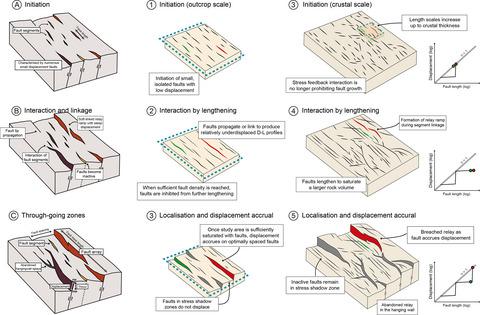当前位置:
X-MOL 学术
›
Basin Res.
›
论文详情
Our official English website, www.x-mol.net, welcomes your
feedback! (Note: you will need to create a separate account there.)
Evolution of normal fault displacement and length as continental lithosphere stretches
Basin Research ( IF 2.8 ) Pub Date : 2021-09-03 , DOI: 10.1111/bre.12613 Sophie Pan 1 , Rebecca E. Bell 1 , Christopher A‐L. Jackson 2 , John Naliboff 3
Basin Research ( IF 2.8 ) Pub Date : 2021-09-03 , DOI: 10.1111/bre.12613 Sophie Pan 1 , Rebecca E. Bell 1 , Christopher A‐L. Jackson 2 , John Naliboff 3
Affiliation

|
Continental rifting is accommodated by the development of normal fault networks. Fault growth patterns control their related seismic hazards, and the tectonostratigraphic evolution and resource and CO2 storage potential of rifts. Our understanding of fault evolution is largely derived by observing the final geometry and displacement (D)-length (L) characteristics of active and inactive fault arrays, and by subsequently inferring their kinematics. We can rarely determine how these geometric properties change through time, and how the growth of individual fault arrays relate to the temporal evolution of their host networks. Here we use 3D seismic reflection and borehole data from the Exmouth Plateau, NW Shelf, Australia to determine the growth of rift-related, crustal-scale fault arrays and networks over geological timescales (>106 Ma). The excellent-quality seismic data allows us to reconstruct the entire Jurassic-to-Early Cretaceous fault network over a relatively large area (ca. 1,200 km2). We find that fault trace lengths were established early, within the first ca. 7.2 Myr of rifting, and that along-strike migration of throw maxima towards the centre of individual fault arrays occurred after ca. 28.5 Myr of rifting. Faults located in stress shadows become inactive and appear under-displaced relative to adjacent larger faults, onto which strain localises as rifting proceeds. This implies that the scatter frequently observed in D-L plots can simply reflect fault growth and network maturity. We show that by studying complete rift-related normal networks, rather than just individual fault arrays, we can better understand how faults grow and more generally how continental lithosphere deforms as it stretches.
中文翻译:

随着大陆岩石圈伸展的正断层位移和长度的演变
正断层网络的发展适应了大陆裂谷。断层生长模式控制着其相关的地震灾害、构造地层演化以及裂谷的资源和CO 2储存潜力。我们对断层演化的理解主要是通过观察活动和非活动断层阵列的最终几何形状和位移 ( D )-长度 ( L ) 特征,并随后推断它们的运动学得出的。我们很少能确定这些几何特性如何随时间变化,以及单个断层阵列的增长如何与其宿主网络的时间演化相关联. 在这里,我们使用来自澳大利亚西北大陆架埃克斯茅斯高原的 3D 地震反射和钻孔数据来确定与裂谷相关的地壳尺度断层阵列和网络在地质时间尺度(>10 6 Ma)上的增长。优质的地震数据使我们能够在相对较大的区域(约 1,200 km 2)。我们发现断层轨迹长度是很早就建立的,在第一个 ca 之内。7.2 Myr 的裂谷作用,以及沿走向向单个断层阵列中心的抛最大迁移发生在 ca 之后。28.5 Myr 裂谷。位于应力阴影中的断层变得不活跃,并且相对于相邻的较大断层出现位移不足,随着裂谷的进行,应变集中在这些断层上。这意味着在D - L图中经常观察到的散点可以简单地反映故障增长和网络成熟度。我们表明,通过研究与裂谷相关的完整正常网络,而不仅仅是单个断层阵列,我们可以更好地了解断层如何生长,以及更普遍地了解大陆岩石圈在伸展时如何变形。
更新日期:2021-09-03
中文翻译:

随着大陆岩石圈伸展的正断层位移和长度的演变
正断层网络的发展适应了大陆裂谷。断层生长模式控制着其相关的地震灾害、构造地层演化以及裂谷的资源和CO 2储存潜力。我们对断层演化的理解主要是通过观察活动和非活动断层阵列的最终几何形状和位移 ( D )-长度 ( L ) 特征,并随后推断它们的运动学得出的。我们很少能确定这些几何特性如何随时间变化,以及单个断层阵列的增长如何与其宿主网络的时间演化相关联. 在这里,我们使用来自澳大利亚西北大陆架埃克斯茅斯高原的 3D 地震反射和钻孔数据来确定与裂谷相关的地壳尺度断层阵列和网络在地质时间尺度(>10 6 Ma)上的增长。优质的地震数据使我们能够在相对较大的区域(约 1,200 km 2)。我们发现断层轨迹长度是很早就建立的,在第一个 ca 之内。7.2 Myr 的裂谷作用,以及沿走向向单个断层阵列中心的抛最大迁移发生在 ca 之后。28.5 Myr 裂谷。位于应力阴影中的断层变得不活跃,并且相对于相邻的较大断层出现位移不足,随着裂谷的进行,应变集中在这些断层上。这意味着在D - L图中经常观察到的散点可以简单地反映故障增长和网络成熟度。我们表明,通过研究与裂谷相关的完整正常网络,而不仅仅是单个断层阵列,我们可以更好地了解断层如何生长,以及更普遍地了解大陆岩石圈在伸展时如何变形。











































 京公网安备 11010802027423号
京公网安备 11010802027423号